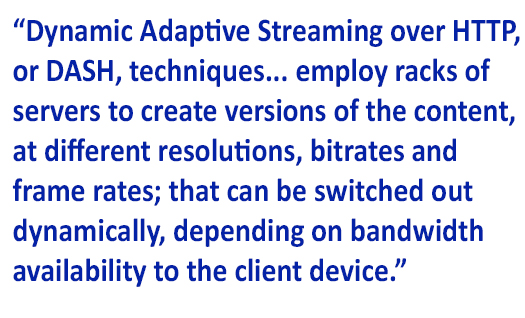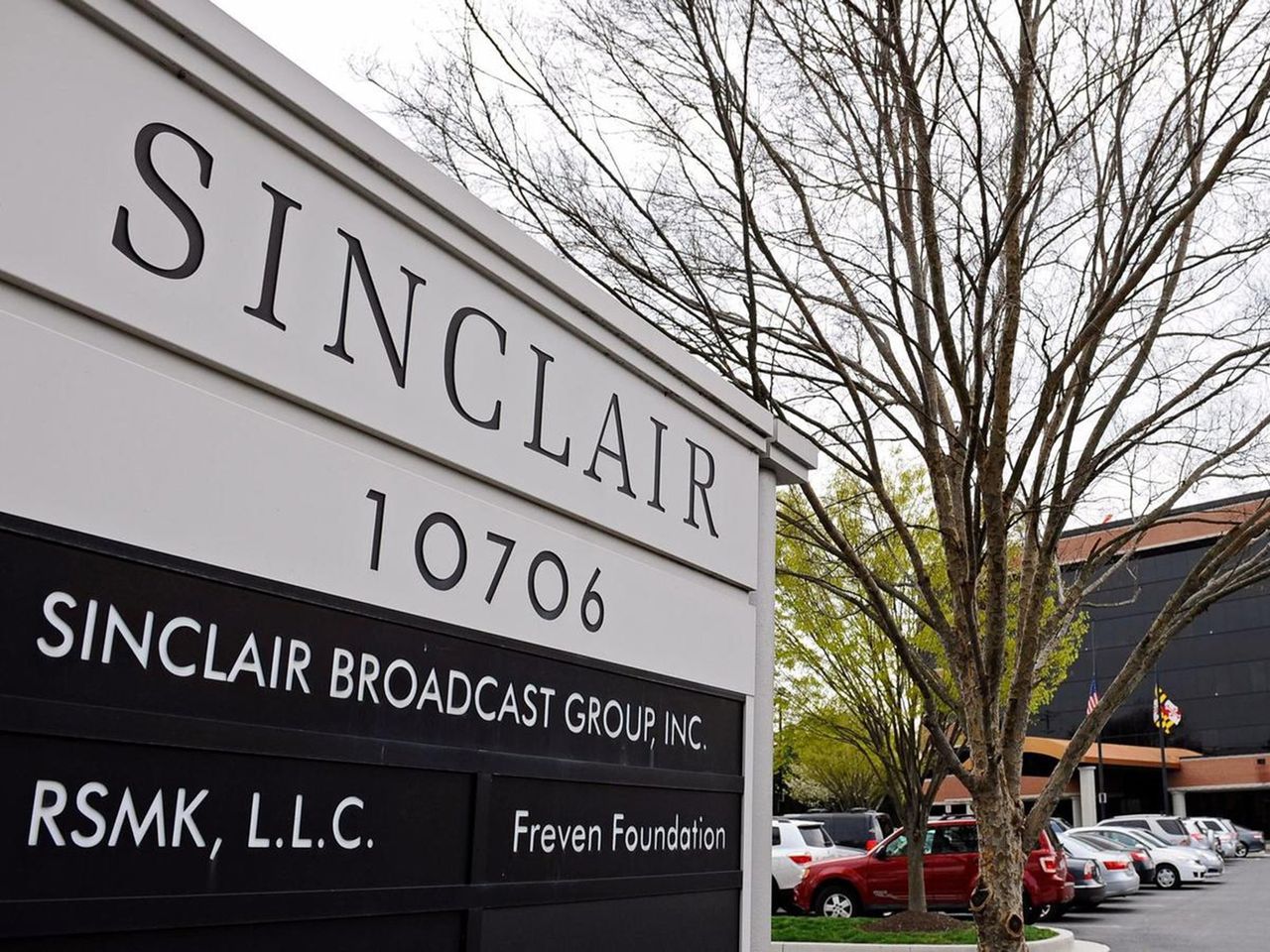The Challenges of OTT

LOS ANGELES—Not a day goes by there is not an article or announcement regarding video distribution over the internet. Coined, “OTT” as in, “over-the-top,” these offerings include video-on-demand, live streaming, user-generated content (e.g., You Tube), as well as news clips, marketing and advertising.
The key feature of OTT is that it’s individually targeted. The consumer chooses what, when, where and on what device to view content. Unlike “one-to-many” broadcast technologies, internet protocols are designed to move data point-to-point. OTT video distribution can deliver content to each viewer, tailored to their connection speed and viewing device, as well as collect viewing information relevant to marketing and advertising.
BOTTLENECK CHECKS
As OTT viewership has increased, internet limitations have become bottlenecks. The first solution was to move content closer to the users, or “the edge,” using private content distribution networks, or CDNs. Last-mile bandwidth choke points are another issue. The solution has been the use of dynamic adaptive streaming over HTTP, or DASH, techniques, including Apple HLS, Microsoft Smooth Streaming and Adobe Dynamic Streaming. These employ racks of servers to create versions of the content, at different resolutions, bitrates and frame rates; that can be switched out dynamically, depending on bandwidth availability to the client device.
In parallel, there have been improvements to video and audio compression that allow for lower bitrates, HEVC, VP9, MPEG-H, AC-4, for example. However, there has also been an increase in demand for higher quality video, up to 4K (3180x2160p24/25/30/60) as well as in high dynamic range and high frame rate. The latest MPEG standards for video, HEVC and Google’s VP9, can deliver 4K at bitrates from 4 to 20 Mbps. So while CDNs and DASH have improved streaming performance, the demand for live streaming and 4K content will continue to challenge OTT delivery.
As the video streaming over the internet load has increased, IP switches and routers have mitigated this increase by increasing the port line rate, up to 10 to 25 Gbps, as well as adding additional buffering to prevent packet loss. However buffering increases the end-to-end delay, or latency, which degrades the quality of service of the video delivery. Higher port line rates require higher internal router and switch bandwidth, as well as faster processing speeds.
MORE POWER, MR. SCOTT!
What other challenges exist? Higher video data rates require more processing power for compression, more fiber capacity—from 10 to 100 Gb—and more energy:
CPU power = CV2fc, where C is capacitance, V is voltage and fc is the CPU clock frequency.
Additionally, more storage is required for the additional versions that are generated (from high-dynamic range 4K to mobile versions). Higher capacity fiber interconnections require IP switches that can handle these higher line data rates, which increase their clock speeds (power) and, as mentioned above, increase the throughput latency.
Potential solutions have been proposed to reduce the overall internet loading due to video streaming, reduce latency and increase video quality of service. One potential solution is to use multicasting techniques. Multicasting is a mode in IP protocols that uses reserved IP addresses to “publish” a common data stream. This technique has been used within closed private data networks, but has yet to be done effectively for internet delivery of OTT services.
IPv4 SQUEEZE
One challenge is that multicasting requires internet service providers (ISPs) to agree to support specific multicast protocols, some of which are proprietary. The second challenge is that it would require either a one-size-fits-all approach of a single video version, or multiple versions of multicast streams to enable DASH protocols. There are 16.8 million IPv4 addresses assigned to global, internetwide multicasts, which may seem more than enough, but if there are just four versions of each video stream, that limits the number of simultaneous video streams to 4.3 million. IPv6 multicast address space is 1.4 x 1036 , so this will not be a problem once IPv6 is in wide use. Another issue with multicast delivery is the need for a protocol to distribute the equivalent of a program guide to all devices for providing information on which video streams are assigned to which multicast addresses.

Another solution is to use peer-to-peer (P2P) techniques. In P2P, edge terminal devices can communicate with other edge devices and share data streams, thus increasing the number of processing nodes, storage and individual bandwidths. This approach would need the user to agree to use a specialized application that can enable P2P. The challenge with P2P is congestion at the local area network as well as privacy and security.
HYBRID BROADCASTING
In Europe, there is an alternate approach to OTT called “HbbTV,” for Hybrid Broadcast Broadband TV. In HbbTV, programs are transmitted using traditional broadcast methods as well as IP streaming. The HbbTV standard allows for the synchronized reception of both signals, thus supporting second-screen viewing as well as delivering enhancements to the broadcast signal that also support interactivity.
In the United States and Korea, the ATSC 3.0 standard has hybrid technologies built in; thus ATSC 3.0 services can be delivered OTT or over-the-air. In addition, ATSC 3.0 employs watermarking technologies to carry the linkage and synchronization information within the program video and audio signals. ATSC 3.0 also incorporates the ability for interactivity, audience measurements, targeted commercials and second-screen applications. ATSC 3.0 is also working on a specification for an application frame work for receiver TV applications.
The OTT ecosystem has many parts—content preparation, content curation, origin servers, distribution servers, CDNs and user applications and players. Some key vendors in the OTT space include Akami and Limelight for CDNs; Elemental and Enivio for encoding and transcoding; MLBAM and Neulion for platform and app development; and Netflix and Amazon as content distributers. There are a myriad of medium to small companies that provide software or services to content distributors.
THE WORLD WILD WEB
Finally Net Neutrality. The internet is not only an amazing technical development, it is also a novel social, business and legal construct. A key component of the internet has been the concept of “Net Neutrality.” Net Neutrality is the principle that all bits are equal, that there is no preference for one set of bits over the other. From a consumer standpoint, this means that all OTT providers have the same opportunity to supply content without any discrimination.
However because Net Neutrality requires any improvement to be available to all internet services, there is no incentive for any one service to pay for improving internet performance, such as increasing the bandwidth limits at an ISP gateway. Some wireless providers have offered “unlimited” access to certain video services, while other services would be under the customer’s data cap. Some cable ISPs have attempted to limit the amount of data for some customer activities, such as P2P streaming. Net Neutrality is in a state of flux and being re-defined by the FCC and the Congress. Stay tuned for updates as they occur.
In summary, OTT has opened up many new opportunities to distribute content to viewers. Viewers have choice not only in programs but in how and when they can watch content that they are interested in. Unfortunately, the IP technologies that the internet is built on, are not easy to scale as OTT becomes more popular. OTT and VOD workflows have changed the distribution workflow for TV. No more is it tape machines, playout servers, master control and automation. Now, we have software-based content management, transcoding, origin servers, authentication servers, distribution servers and CDNs.
There are business, legal and societal challenges that are in continual evolution. The current challenge for OTT is true live streaming of popular content such as sports and news. Live streaming requires lowest latency possible, while handling millions of simultaneous viewers, and delivering good quality video and audio.
Perhaps OTT will replace broadcast distribution technologies. However, today’s existing broadcast TV distribution methods of OTA, cable, satellite and fiber, use well-proven and widely deployed technologies to deliver TV programs, live or prerecorded, to the vast TV audience, without limits to viewership, quality and with minimum delay.
Get the TV Tech Newsletter
The professional video industry's #1 source for news, trends and product and tech information. Sign up below.

im DeFilippis is CEO of TMS Consulting, Inc. in Los Angeles, and former EVP Digital Television Technologies and Standards for FOX.
